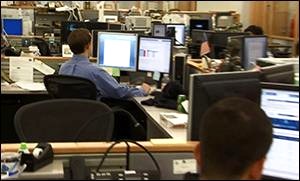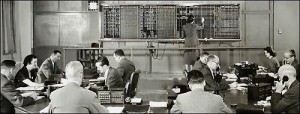By Pam Martens and Russ Martens: August 22, 2019 ~

Photo of the Trading Floor at the New York Fed (Obtained by Wall Street On Parade from an Educational Video Despite Stonewalling by the New York Fed)
According to KPMG’s 2017 and 2018 audit of the Federal Reserve Bank of New York (New York Fed), which is just one of the 12 regional banks of the Federal Reserve System, it has provided more than half of all monies flowing to the U.S. Treasury from regional Fed banks since President Donald Trump took office. In 2017, the New York Fed shipped off $44.6 billion of the total $80.6 billion of all 12 regional banks that was remitted to the U.S. Treasury. In 2018, the New York Fed’s remittance was $33.6 billion of the total $65.3 billion from the regional Fed banks.
But there was some fancy footwork in two pieces of Congressional legislation that were passed in 2018 that boosted the amount the New York Fed and other regional Fed banks would be shipping off to the Treasury to help reduce the budget deficit by reducing the amount of surplus the Fed banks held. This is how KPMG explained it in the 2018 audit report:
“In accordance with the Federal Reserve Act, the Bank remits excess earnings to the Treasury after providing for the cost of operations, payment of dividends, and reservation of an amount necessary to maintain the Bank’s allocated portion of the aggregate surplus limitation.
“For the year ending December 31, 2017 and through February 8, 2018, the aggregate surplus limitation was $10 billion. On February 9, 2018, the Budget Act reduced the aggregate surplus limitation to $7.5 billion, which required the Reserve Banks to make a lump-sum payment to the Treasury in the amount of $2.5 billion; the payment was remitted to the Treasury on February 22, 2018, and the [New York Fed] Bank’s share of this remittance was $788 million. After making the transfer required by the Budget Act, the Bank’s allocated portion of the aggregate $7.5 billion surplus was $2.4 billion.
“On May 24, 2018, the Economic Growth Act reduced the aggregate surplus limitation to $6.825 billion, which required the Reserve Banks to make a lump-sum payment to the Treasury in the amount of $675 million; the payment was remitted to the Treasury on June 21, 2018, and the Bank’s share of this remittance was $213 million. After making the transfer required by the Economic Growth Act, the Bank’s allocated portion of the aggregate $6.825 billion surplus was $2.2 billion.”
The New York Fed’s remittances to the U.S. Treasury for the combined years of 2017 and 2018 were $14.1 billion more than for years 2015 and 2016.
The New York Fed is uniquely able to make these monster payments to the U.S. Treasury because it is the only one of the 12 regional Fed banks that has its own trading floor. We had previously attempted to provide our readers with a photo of that trading floor by making a polite request for a photo to the New York Fed. It denied our request. Fortunately, we located the photo above from one of the Fed’s educational videos.
The New York Fed has a trading floor because it is the only regional Fed bank allowed to carry out the so-called open market operations on behalf of the U.S. central bank, the Federal Reserve Board of Governors.
The New York Fed is unique in another troubling way: its owners are the largest mega banks on Wall Street, which own the bulk of its 205 million shares of its issued stock. Those are the same mega banks that are serially charged with engaging in fraudulent activities to rip off investors and U.S. consumers but whose executives never seem to be relocated to the inside of a jail cell.
The New York Fed was also the only regional Fed bank to oversee the disbursement of the bulk of the secret $29 trillion that it doled out to prop up these mega banks and their foreign bank derivative counterparties from December 2007 to at least the middle of 2010 while the country was dealing with the economic collapse caused by these very same Wall Street mega banks.
And the final perverse thing about the New York Fed is that while it needs the goodwill of the mega banks to carry out its open market operations, it is also the Federal regulator of these same bank holding companies – that own the New York Fed as its largest shareholders.
And despite all of this, Congress refuses to take any meaningful actions to reform this crony system.


